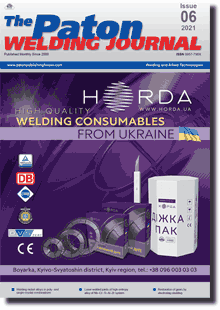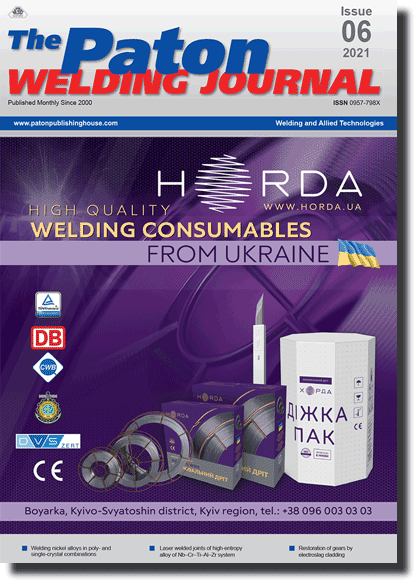| 2021 №06 (03) |
DOI of Article 10.37434/tpwj2021.06.04 |
2021 №06 (05) |

The Paton Welding Journal, 2021, #6, 26-31 pages
Structure of laser welded joints of multicomponent high-entropy alloy of Nb–Cr–Ti–Al–Zr system
V.D. Shelyagin1, A.V. Bernatskyi1, O.V. Siora1, V.I. Bondareva1 and M.P. Brodnikovskyi2
1E.O. Paton Electric Welding Institute of the NASU. 11 Kazymyr Malevych Str., 03150, Kyiv, Ukraine. E-mail: office@paton.kiev.ua
2I.M. Frantsevich Institute for Problems of Materials Science of the NAS of Ukraine 3 Krzhyzhanovskyi Str., 0312, Kyiv, Ukraine
Abstract
In the work the authors studied the problems of laser welding of joints of high-entropy alloy of Nb–Cr–Ti–Al–Zr system. The results of differential thermal analysis of the initial material are presented. Results of X-ray phase analysis of the alloy were analyzed. A conclusion was made about existence of bcc solid solution based on niobium and solid solution based on ZrCr2 intermetallics in the alloy, as well as existence of two niobium-based solid solutions with different chemical composition in the alloy. Analysis of the influence of alloy crystallization rate on its microstructure was performed. It is shown that the ratio of the quantity of dendrites and eutectic can change, depending on the cooling rate. Obtained results of investigations on formation of a dendrite structure were furtheron used at optimization of laser welding modes. In this work the authors studied the influence of such parameters as radiation power and laser welding speed on weld microstructure formation. Mechanical properties of butt joints at uniaxial static tension were studied. It was found that material softening which leads to destruction is influenced by the feature of distribution of residual thermal stresses that is determined by the mode of heat input and removal during welding. It is shown that formation of the majority of the defects is related to a feature of nonequilibrium crystallization of multicomponent high-entropy high-temperature alloys. In order to prevent their formation, it is rational to take measures for optimizing the technology parameters, aimed at increasing the melt cooling rate, in order to produce a more equilibrium structure. 15 Ref., 5 Figures.
Keywords: multicomponent high-entropy alloy, laser welding, butt joints, structure, mechanical properties, defects
Received 21.04.2021
References
1. Boyer, R.R., Cotton, J.D., Mohaghegh, M., Schafrik, R.E. (2015). Materials considerations for aerospace applications. MRS Bulletin, 40, 12, 1055-1066. https://doi.org/10.1557/mrs.2015.2782. Sanin, V.N., Ikornikov, D.M., Andreev, D.E. et al. (2017). Synthesis of Cast High Entropy Alloys with a Low Specific Gravity by Centrifugal Metallothermic SHS-Methods. Advanced Materials and Technologies, 3, 24-33. https://doi.org/10.17277/amt.2017.03.pp.024-033
3. Küpper, D., Heising, W., Corman, G. et al. (2017). Get ready for industrialized additive manufacturing. DigitalBCG, Boston Consulting Group. https://www.bcg.com/publications/2017/lean-manufacturing-industry-4.0-get-ready-for-industrialized-additive-manufacturing
4. George, E.P., Raabe, D., Ritchie, R.O. (2019). High-entropy alloys. Nature Reviews Materials, 4, 8, 515-534. https://doi.org/10.1038/s41578-019-0121-4
5. Senkov, O.N., Miracle, D.B., Chaput, K.J., Couzinie, J.P. (2018). Development and exploration of refractory high entropy alloys - A review. Journal of materials research, 33, 19, 3092-3128. https://doi.org/10.1557/jmr.2018.153
6. Zhang, W., Liaw, P. K., Zhang, Y. (2018). Science and technology in high-entropy alloys. Science China Materials, 61, 1, 2-22. https://doi.org/10.1007/s40843-017-9195-8
7. Chang, X., Zeng, M., Liu, K., Fu, L. (2020). Phase Engineering of High-Entropy Alloys. Advanced Materials, 32, 14, 1907226. https://doi.org/10.1002/adma.201907226
8. Yan, X., Zhang, Y. (2020). Functional properties and promising applications of high entropy alloys. Scripta Materialia, 187, 188-193. https://doi.org/10.1016/j.scriptamat.2020.06.017
9. George, E.P., Curtin, W.A., Tasan, C.C. (2020). High entropy alloys: A focused review of mechanical properties and deformation mechanisms. Acta Materialia, 188, 435-474. https://doi.org/10.1016/j.actamat.2019.12.015
10. Senkov, O.N., Wilks, G.B., Scott, J.M., Miracle, D.B. (2011). Mechanical properties of Nb25Mo25Ta25W25 and V20Nb20Mo20Ta20W20 refractory high entropy alloys. Intermetallics, 19, 5, 698-706. https://doi.org/10.1016/j.intermet.2011.01.004
11. Brodnikovsky, N.P., Kulakov, A.S., Krapivka, N.A. et al. (2016). Electron Microscopy and Strength of Materials, 22, 20-30. http://www.materials.kiev.ua/publications/EMMM/2016/4.pdf
12. Zhao, Y.Y., Lei, Z.F., Lu, Z.P. et al. (2019). A simplified model connecting lattice distortion with friction stress of Nbbased equiatomic high-entropy alloys. Materials Research Letters, 7, 8, 340-346. https://doi.org/10.1080/21663831.2019.1610105
13. Panina E., Yurchenko N., Zherebtsov S. et al. (2019). Laser beam welding of a low density refractory high entropy alloy. Metals, 9, 12, 1351. https://doi.org/10.3390/met9121351
14. Lopes, J.G., Oliveira, J.P. (2020). A short review on welding and joining of high entropy alloys. Metals, 10, 2, 212. https://doi.org/10.3390/met10020212
15. Kang, B., Lee, J., Ryu, H.J., Hong, S.H. (2018). Ultrahigh strength WNbMoTaV high-entropy alloys with fine grain structure fabricated by powder metallurgical process. Materials Science and Engineering: A, 712, 616-624. https://doi.org/10.1016/j.msea.2017.12.021
Suggested Citation
V.D. Shelyagin, A.V. Bernatskyi, O.V. Siora, V.I. Bondareva and M.P. Brodnikovskyi (2021) Structure of laser welded joints of multicomponent high-entropy alloy of Nb–Cr–Ti–Al–Zr system. The Paton Welding J., 06, 26-31.The cost of subscription/purchase order journals or individual articles
| Journal/Currency | Annual Set | 1 issue printed |
1 issue |
one article |
| TPWJ/USD | 384 $ | 32 $ | 26 $ | 13 $ |
| TPWJ/EUR | 348 € | 29 € | 24 € | 12 € |
| TPWJ/UAH | 7200 UAH | 600 UAH | 600 UAH | 280 UAH |
| AS/UAH | 1800 UAH | 300 UAH | 300 UAH | 150 UAH |
| AS/USD | 192 $ | 32 $ | 26 $ | 13 $ |
| AS/EUR | 180 € | 30 € | 25 € | 12 € |
| SEM/UAH | 1200 UAH | 300 UAH | 300 UAH | 150 UAH |
| SEM/USD | 128 $ | 32 $ | 26 $ | 13 $ |
| SEM/EUR | 120 € | 30 € | 25 € | 12 € |
| TDNK/UAH | 1200 UAH | 300 UAH | 300 UAH | 150 UAH |
| TDNK/USD | 128 $ | 32 $ | 26 $ | 13 $ |
| TDNK/EUR | 120 € | 30 € | 25 € | 15 € |
AS = «Automatic Welding» - 6 issues per year;
TPWJ = «PATON WELDING JOURNAL» - 12 issues per year;
SEM = «Electrometallurgy Today» - 4 issues per year;
TDNK = «Technical Diagnostics and Non-Destructive Testing» - 4 issues per year.


